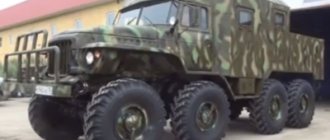We are opening a section dedicated to homemade, tuning, low-volume, vintage and other exotic trucks.
For many years, along with the official automobile industry, there has been a “parallel” industry in our country. Garage craftsmen who have never worked at car factories create, some better or worse, the most unexpected car designs.
When you meet this truck for the first time, you take it for some kind of three-axle modification of a ZIL, “modernized” at a car depot. True, the alteration was done carefully: a homemade “sleeping bag”, a platform from a long-range truck adjusted to the dimensions of the chassis. The style of the car resembles an American long-haul truck.
Taking a closer look, you notice that the wheels are not “Zilov”: the front wheels have a foreign size of 22.5 inches and protective rings on top of the fastening nuts, ensuring safety. The rear third axle is made lifting. This means that the rear axle is not driven, the wheel arrangement is 6x2, and the car is designed for roads where axle load is limited. In our country, such a chassis design was used only on one truck – the MAZ-516, known from the old movie “The World Guy.” No, that MAZ has nothing to do with it - the chassis of the car we are talking about was taken from a foreign car. The hunch is confirmed by the frame of a characteristic European red color and the rear underride guard made by the company.
The owner of the car is called Alexander. He is a truck driver with extensive experience. Once he worked on ZIL-130 flatbeds and MAZ trucks. Since perestroika, he has been engaged in transportation, being the owner of a truck. Like many drivers, Alexander was not satisfied with the consumer qualities of serial domestic trucks. Foreign cars of that time were not as accessible as they are now, and even with all their advantages, they were also mass-produced products designed for the average consumer. Alexander decided to make the car “for himself”, taking into account his own tastes and needs.
As the hero of our story admits, he always liked hooded trucks. He owned a Ural, then switched to a ZIL-133GYA, replacing the old “one hundred and thirtieth” cabin on his car with a new one, taken from the ZIL-4331. In each of these trucks, the owner changed and completed many things, gaining design experience.
When creating the current vehicle, Alexander set a goal to install a tilt platform of the maximum possible volume on the chassis of a single (without a trailer or semi-trailer) truck. In the late 1990s, single trucks with a body capacity of more than 40 m 3 were rare, and the owner of such a vehicle received more orders for cargo transportation. At the same time, the truck had to remain under the hood. The solution suggested itself: to create a hybrid of the Zilov hooded cab with a reliable chassis from an imported car with a fairly long frame.
After a short search, Alexander fell into the hands of a long three-axle Volvo F7, one of the foreign cars that ingloriously disappears in the backyards of Moscow and Moscow region garages. The frame and axles for the homemade truck were suitable without modifications. The power steering was also left over from the Swedish car.
When choosing an engine, the creator of the car chose the YaMZ-238 eight-cylinder diesel engine. The unit is good for everyone: powerful, high-torque and at the same time affordable, unpretentious in maintenance. And there are no problems with spare parts. First, Alexander installed a MAZ gearbox on his car. It turned out that it does not fit well with the Volvo drive axle gearbox in terms of gear ratios. The dynamics and maximum speed were excellent, but the traction characteristics of the transmission left much to be desired. The box from KamAZ turned out to be more suitable, and Alexander installed it. Thanks to general standardization, parts of braking systems and electrical equipment were not difficult to “grow together” into a single whole.
What ZIL trucks will look like if they are tuned: a few examples
I propose to start this issue with the unusual ZIL-4331, which was converted into a long-range truck by the hands of a master.
Judging by the name on the windshield, "Forward", this is probably the name of the car that the driver gave him. To adapt the car to long-distance flights, the roof height was increased and the cabin itself was lengthened. The fairing painted in the Russian tricolor sets a certain patriotism. From the end you can see Zhiguli headlights, which are covered by tinting.
Here is ZIL-131. His appearance looks quite strange and unusual. And maybe it’s not the 131st. There was a time when Zilov cabins were supplied to the AMUR enterprise. Through their efforts, the road version of ZILKs was produced. And the fact that in the photo it’s more like a hodgepodge. There is a long frame and road rear drive axles. Modern onboard platform and crane. The front axle is not driven and the cabin is from ZIL-131 or AMUR roofing felts.
The long hood of this truck resembles the ZIL-133GYA. Such a hooded truck with a convex radiator grille clearly has a handy driver who turned the car into a long-range tractor. These trucks were also called “crocodiles.” The main idea of the ZIL-133GYA was based on the installation of various crane superstructures. And this example most likely had a past associated with the crane, but its owner remade it, as they say, “for himself.” Work included fabricating a sleeper compartment, raising the roof height, installing larger fuel tanks, and an updated front bumper.
This truck was seen on the roads of Ukraine. One of the later Zilov modifications of the ZIL-130, most likely with a dump body.
To give the car a little style, the owner did a good job: he replaced the round headlights with rectangular ones from a VAZ-2105. There is a homemade air intake on the hood. The bumper skirt with UA stickers also adds style.
This is another ZIL-133GYA, whose work was carried out over long distances. I note that the owner of this truck approached the modification in a very original way. Its elegant sleeping compartment was created from a two-row cab borrowed from a fire truck. Where in the sleeping area there was a separate sleeping place. To get there you had to use your own doors. Behind the cab there is a vertical exhaust and a cargo platform with an awning.
Source
Description and operating conditions of the engine
The D 645 engine replaced its gasoline predecessor ZIL-508.
During development, the designers took the German Deutz engine and Motorpal high-pressure pump as a model. The main advantage of diesel was its volume-film mixture formation. This meant that the fuel-air mixture was prepared simultaneously in two ways: by getting into the middle of the air charge and spreading along the chamber wall. Today, preference is given to more advanced engines with film mixture formation, in which fuel in the form of a thin film 12-14 microns thick is actively mixed with air and only after that is introduced into the combustion zone. Such engines smoke less and run smoother. However, for its time, the D 645 was quite advanced. Unlike its gasoline predecessor, it was more economical and provided confident starting even when fully loaded. In addition, the ZIL-4331 was equipped with a new nine-speed gearbox. This gave the driver the opportunity to compare the engine operating mode with the current load.
The engine was specially designed to improve the performance of equipment
Ideas for tuning a Soviet ZIL truck with your own hands - laid out in order
GAZ 53 trucks have not been produced from the production line for a long time, and those models that are still driving on the roads need various modifications. The design of the car no longer meets modern requirements - the engine does not have enough torque, the design does not meet modern requirements. In a word, the GAZ 53 model requires tuning.
Conversion and tuning of a truck into an SUV with a living compartment
Additional information ZIL 431410
Onboard tractor-trailers (ZIL-431510 - long-wheelbase; dimensions in the diagram in parentheses) have been produced by the Likhachev Moscow Automobile Plant since 1986. They are modernized vehicles of the ZIL-130 family, produced since 1962. Since 1977, the ZIL-130-76 car was produced, and since 1980, the ZIL-130-80. The body is a wooden platform with metal transverse base bars, with folding rear and side sides. Installation of extension sides and an awning with a frame is provided. On ZIL-431510 the side panel consists of two parts. The cabin is three-seater, located behind the engine. The driver's seat is adjustable in length, height and backrest tilt.
Brakes. The service brake system is with drum mechanisms (diameter 420 mm, width of the front linings 70, rear linings 140 mm, cam release) with a dual-circuit pneumatic drive, with a brake force regulator. Brake chambers: front - type 16, rear - type 24/24 with spring energy accumulators. The parking brake is applied to the brakes of the rear wheels from spring energy accumulators, the drive is pneumatic. The spare brake system is combined with the parking one. The trailer brake drive is combined (two- and single-wire). Upon request, vehicles can be equipped with a brake drive without separation along the axles and with a single-line drive for trailer brakes (ZIL-130-80 car brakes). There is an alcohol fuse against condensate freezing.
Important Technical characteristics and operating principles of the best Zarya rotary mowers: reviews, prices, videos
ZIL-431411 and ZIL-431511 - “HL” version for cold climates (down to minus 60°C); ZIL-431416 and ZIL-431516 - for export to countries with temperate climates; ZIL-431417 and ZIL-431517 - for export to countries with tropical climates; ZIL-431917 and ZIL-432317 - with shielded electrical equipment for export to countries with temperate and tropical climates; ZIL-431610 and ZIL-431710 - gas-cylinder vehicles running on compressed natural gas and gasoline; ZIL-431810 - gas-cylinder vehicles running on liquefied gas (based on 431410).
This is interesting: Popular municipal vehicles on a truck chassis ZIL-431412
With your own hands
Dump trucks GAZ 53 is not a vehicle from the “premium” series, it is a hard worker and is intended for transporting goods. Therefore, tuning is mainly aimed at improving its technical characteristics, and not at its spectacular appearance. The owners of such cars are unlikely to contact auto centers and try to do all the work themselves.
The production and sale of the new GAZ-53 truck ceased in 1993. But this car entered the hearts of our citizens so deeply that we wanted this production not to stop, and every year more and more advanced modifications of the GAZ-53 came off the assembly line. But this is already from the category of fantasy.
Therefore, there is only one option left to improve our favorite, namely, tuning the cabin or interior of the GAZ-53.
How exactly you will do this is up to you, the main thing is that the end result is not a painted parrot, because mocking a people’s favorite like that would be to your detriment, but something truly fascinating.
For example, take one well-known transmission, where a real hummer was made from a GAZ-53, with huge ground clearance, two axles, four doors instead of two, with a more advanced suspension, a body made in the American style and much more. Americans would definitely envy our GAZ-53 Hummer.
Engine
First of all, GAZ tuning is aimed at improving the power unit. If the “original” motor becomes unusable, it does not always make sense to repair it. A good alternative replacement option is diesel with its undeniable advantages:
- Low fuel consumption gas 53;
- Long service life; during normal operation, a diesel engine runs 400 and 500 thousand km before major repairs;
- Easy to maintain, you only need to change filters and oil on time. The motor does not need diagnostics to identify faulty spark plugs, I/O wires, switch and distributor;
- High efficiency.
The most popular for the “fifty-third” was the engine of the Minsk Motor Plant D-245 (D-240, D-243). The motor has a simple design and reasonable price. In addition, there are not so many improvements during reinstallation.
The process of installing the D-245 engine on a GAZ 53 truck
The following changes will have to be made:
- Digest on the mounting frame;
- Replace the fuel tank;
- Replace and modernize the exhaust system;
- Make changes to the electrical wiring;
- Make an adapter and modify the driveshaft.
It is possible to install a foreign-made engine, for example, from Mercedes. The four-liter “German” is even more economical than the Belarusian MTZ, its consumption does not exceed 15 liters per 100 km.
Cabin and salon
The GAZ 53 cabin is made of good thick metal, but over time any metal structure rusts. It has to be welded and repainted. The cabin cannot always be repaired; often its wings, bottom and running boards rot. Many owners of “53s” install the cabin from the GAZ 3307 model, and it fits with virtually no modifications.
An example of tuning the interior of a GAZ 53
New GAZ 53 cabs are offered for purchase by various companies; parts are supplied to order. Colors and equipment may vary, and the price depends on the equipment. The first configuration of the cabin (with doors and tail) costs about 80 thousand rubles.
Not everyone tunes a car just to improve its technical condition. Someone paints the cabin metallic, installs additional luxurious optics, additional decorative steps. The red bumper looks original against the background of the blue metallic cab.
About the history of the Likhachev Plant
The Moscow Likhachev Automobile Plant was the oldest automobile manufacturing company in our country. He “didn’t live” until his 100th birthday just a few years ago. “The AMO (Automobile Moscow Society) plant was founded on August 2, 1916.
By the beginning of the revolutionary upheavals, the plant had not yet been completed, but was already in a high degree of readiness. Before the general devastation and economic collapse due to the civil war, the AMO plant managed to produce more than 1,300 1.5-ton Fiat-15 Ter trucks from Italian vehicle kits.
The first ZIL truck AMO-F15, based on the Fiat-15 Ter
This car served as the basis for the creation of our own model, the mass production of which began only in 1925. The revival and development of the first automobile production in Russia and the USSR is inextricably linked with the name of Ivan Likhachev, who was the director of the plant in 1926-1940.
After the death of this outstanding figure in 1956 (then already the Minister of Motor Transport and Highways of the USSR), both the plant itself and every car coming off the assembly line received his name. From 1931 to 1956, the enterprise was called the “Stalin Plant”, and the cars it produced were called “ZIS”.
The millionth ZIL-130 was made in 1974.
The most popular models in the history of the plant were the ZIL-130 and ZIL-131 trucks; ZIL-151 and ZIL-156. In addition, the Likhachev Plant became a “donor” of models for the Kutaisi Automobile Plant (built in 1951) and (built in 1976). The well-known classic KamAZ-5320 is a development of the ZIL design bureau.
In 2003, the production of ZIL-4331 was put to an end.
Currently, the Likhachev Plant has been liquidated; its territory is being actively developed with new residential complexes, which, according to Moscow Mayor Sergei Sobyanin, will soon house over thirty thousand people, as well as office and retail buildings. Almost all workshops and old buildings on ZIL sites have been demolished. Including the memorial museum of the plant, along with the office of Ivan Likhachev.
Only workshop No. 6 is functioning, for the assembly of government limousines ZIL-4112R - the heirs of special cars for senior management, popularly nicknamed “member carriers”.
Important Motoblocks: purpose and features of choice
“ZIL will soon become an innovative platform where high-tech production of competitive cars will be concentrated,” Moscow Mayor Sergei Sobyanin, 2013, on the eve of the distribution of the plant’s land for total real estate development.
In part, the collapse of the production of ZIL-4331 trucks and the entire plant as a whole was natural in the new economic realities. Despite its obvious advantages, the ZIL-4331 was clearly late in its release - a medium-tonnage truck with high fuel consumption was no longer in great demand in the new economic conditions. As for the plant, its territory is 300 hectares of land almost in the center of the capital, on the banks of the Moscow River! There is no need to say that this land, in terms of its value, has become practically priceless in our time.
Year 2014: In place of the demolished workshops, the ZIL-Art residential complex is growing at an accelerated pace.
This is interesting: Technical characteristics of the dump truck and other modifications of the ZIL-4331 truck: read in detail
Improved driver comfort
One of the significant problems of domestically produced cars is the presence of serious noise in the cabin. This noise appears not only as a result of the movement of the car, but also from the friction of various trim elements. And the operation of the power unit leads to unpleasant vibrations inside the car. To reduce the impact of this “chronic disease”, it is recommended to use vibration and sound insulation.
Another option for tuning the ZIL 130 is replacing the standard seat upholstery made of leatherette. Some motorists decide to replace the entire interior trim. Many truck owners complain that the seats are very hard. The problem can be solved by installing pneumatic seats.
Installing a good radio and speakers is another step that will help you improve your ZIL 130. As you can see, there are actually a lot of tuning options, you just need to try to implement some of them.
Features of appearance and modifications
In the post-war years, almost all trucks had a bunch of shortcomings; the emphasis was on quantity rather than quality. However, by 1956 the situation had changed and the ZIL 130 was transformed from its predecessors.
Over the entire period of production, many different modifications were produced, including special fire engines, on-board vehicles, dump trucks, truck cranes, etc. Having a lifting capacity of three tons, it received the following versions:
- 130A – tractor equipped with a coupling device and a combined brake system;
- 130B – ZIL 130 dump truck with a standard base of 3.8 m;
- 130V – with a base of 3.3 m;
- 130 VT – reinforced bridges;
- 130G – designed for transporting oversized cargo;
- 130 D – short dump truck for construction with a short wheelbase;
- 130B1 - a truck tractor, the total weight could reach more than 14 tons;
- 130D1 - the base model for ZIL MMZ 4502 trailers, could weigh up to 15 tons.
The manufacturer also produced limited-edition lettered trucks designed for operation in various climate conditions with any tires and attachments.
Price ZIL-157
However, given the former prevalence of these off-road conquerors, even today there is no shortage of offers for the sale of ZIL-157, the vast majority of which were produced in the 70s/80s.
Different prices. Those that are not running and require serious restoration are sold for 50-80 thousand rubles. For trucks that have “remained viable,” they ask from 150 to 200 thousand rubles. Many advertisements on the Internet appear under the heading: “Selling a mortar” or “Selling a cleaver.”
Numerous rumors about ZIL-157s “available in long-term storage” in the Armed Forces have no basis. Of course, no one has stored this outdated model anywhere for a long time. You can still find a ZIL-131 that has been removed from conservation, but there is definitely no “Mormon” one.
Be that as it may, this truck model certainly has a happy destiny. It was not only replicated in hundreds of thousands of copies, but also served its country faithfully; was able to become a living legend, one of the brightest symbols of the Soviet era, even before the “stagnation” of the late Brezhnev and Gorbachev’s “perestroika” that followed.
ZIL 4331 family
Now let's pay attention to the modifications of the car, which has about ten types of assembly and even more options for additional equipment:
- Model 433102 includes a standard chassis and a 4500 mm wheelbase. The ZIL 645 diesel engine easily develops power up to 185 hp. A special feature of this truck is the ability to install equipment of different weights, for example, a manipulator or tanks of any volume.
- The fire-fighting version of the 433104 vehicle also gained recognition among domestic enterprises and was used by fire services for a long time. The same applies to similar versions of the car, which were produced specifically for the needs of public utilities. Depending on the needs of a particular enterprise, the technical characteristics and equipment of the van could differ slightly.
- 433110 received a new gasoline engine, but with less power of 130 hp.
- The original model 43314B received positive reviews due to the possibility of installing a double cabin that could accommodate up to seven passengers, including the driver. The wheelbase of such a car was 6100 mm, and the engine ran on diesel.
- Later, version 4332A was released with an enlarged cabin, where a sleeping bag was additionally mounted.
- A special tipper version of the truck can transport loads of up to six tons.
- ZIL 43360 includes a special power plant and has a shortened base.
- At the beginning of the 21st century, some engineers began to equip the ZIL 4331 with the revolutionary YaMZ 236 engine with an incredible power of 240 hp. But it is worth noting that the installation of such a unit required additional investments and the average price was 80 thousand rubles.
In fact, there are even more types of car that will have similar characteristics and differ in minor details. It will take a very long time to dwell on all the models and disassemble them in detail, and if you wish, you can always use information from Wikipedia. I would also like to note that all of the above cars have a rear-wheel drive, front-engine layout.










